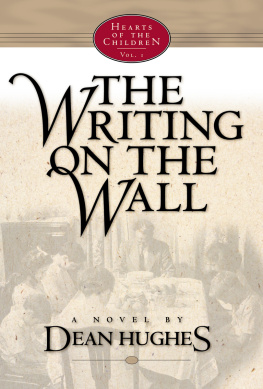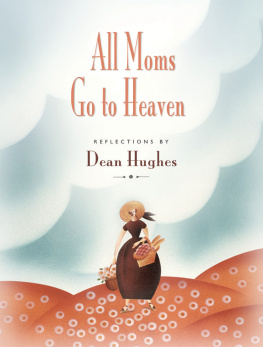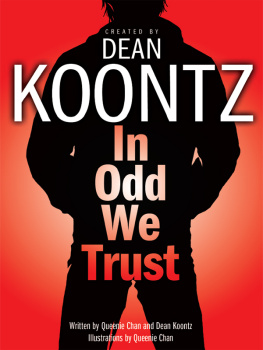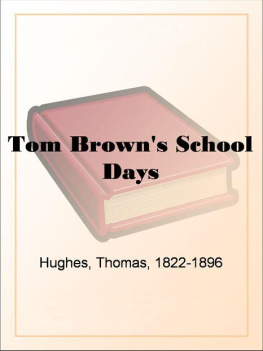The Writing on the Wall
Hearts of the Children, Vol. 1
Dean Hughes
2001 Dean Hughes.
All rights reserved. No part of this book may be reproduced in any form or by any means without permission in writing from the publisher, Deseret Book Company, P.O. Box 30178, Salt Lake City Utah 30178. This work is not an official publication of The Church of Jesus Christ of Latter-day Saints. The views expressed herein are the responsibility of the author and do not necessarily represent the position of the Church or of Deseret Book. Deseret Book is a registered trademark of Deseret Book Company.
All characters in this book are fictitious, and any resemblance to actual persons, living or dead, is purely coincidental.
Hughes, Dean, 1943
The writing on the wall /Dean Hughes
p.cm. (Heartsof the children; v.1)
Includes bibliographicalreferences.
ISBN-10: 1-57008-725-3(hardbound: alk. paper)
ISBN-13:978-1-60641-172-8 (paperbound)
1.Mormon familiesFiction. 2.Salt Lake City (Utah)Fiction.
I. Title.PS3558.U36 W75 2001813'.54dc21
2001004151
Printed in the United States of America
R. R. Donnelley and Sons, Crawfordsville, IN
10 9 8 7 6 5 4 3 2 1
For David and Shauna Weight
Preface
Hearts of the Children is a sequel series. It tells the story of the Alexander and BeaThomas family during the 1960s and 70s. Many readers will already know theThomases from my earlier five-volume Children of thePromise series, which was set in the era ofWorld War II. These new books will feature the next generation, thecoming-of-age period for the children born toward the end, orjust after the end, of the war. I have tried to write Hearts of theChildren so that it can stand alone, withnew stories about a new generation.
I am often asked whether any of the Thomases are based onactual people. The answer is no; they are all fictional. I place them inhistory, and I try to be accurate about the events and places where they live,but they exist only in my head, and I hope, by now, in theheadsand maybe the heartsof the readers.
Fiction has its power. Perceptions and emotions of imaginarycharacters can be understood more completely than we ever understand eachother, and those perceptions can recreate a feel for history in a way that israre in a history book. But careless fiction can also distort. Thats why Iinclude many perspectives. I try to create characters who differ in their viewsand values, and by doing so, bring a realistic complexity to the time Imwriting about.
I try to disturb history as little as possible, and yethistorical fiction always starts with a basic distortion: invented charactersare dropped into the stream of real events. In The Writing on the Wall, for instance, Gene Thomas plays for East High in afootball game on October 26, 1962. He is the quarterback. The fact is, no onenamed Gene Thomas was going to East High that year. But East did play OlympusHigh that night, and the final score really was 21 to 13, as I report. Theperfect pass Gene throws is fictional, and thats a distortion, but I have keptthe score right, and East actually did reach the semi-final game inthe state championships that year, just as it happens in my novel.
Where I can, I use real names. President Blythe Gardnerreally was the mission president in the South German Mission in 1964 (I know; Iwas there), and President John Fetzer did take over for him that summer. Butthere was no Elder Bentz or Elder Johns. And by the way, my friend Jim Backmanreally was student-body president at East High in 196162, but,of course, he didnt turn over the presidency to the fictional GeneThomas. (Had he done so, the students at East might have been quite confused.)
One of my interests in this new series is the way that theinfluence of a generation, or of a specific married couple, extends to itschildren, and then, to their children. But that means I have many characters inthese books. I feature one of the childrenactually the oldest,in each casefrom four second-generation families, sothat four cousins become the main characters. You may find it confusing to keeptrack of all their brothers and sisters. To help out, I am including, at theend of this preface, a family chart to show the entire Thomas family as itexists at the beginning of the series.
I dont use footnotes mainly because most of my history isgeneral background rather than specific historical events, but I do want tosuggest some books that make for interesting reading on the era of thesenovels. When I began the research for this series, I thought I wouldntneed to work very hard this time, since I graduated from high school in 1961and know the time period. But memories are slippery, and any individual seesonly a tiny portion of a time. It has turned out that Ive had to read a greatdeal.
Some books I found useful as general introductions to theissues and events of the era are: Grand Expectations: The United States,19451974, by James T. Patterson(Oxford University Press, 1996); The Sixties: From Memory to History,ed. David Farber (University of NorthCarolina Press, 1994); The Best and the Brightest, by David Halberstam (Fawcett, 1969); and How We Got Here: The 70s, by David Frum (Basic Books, 1970). David Halberstamsbook about the fifties is also a helpful introduction to the decades that follow: The Fifties (Fawcett, 1993). Jon Margolis has also written a really informativebook on 1964: The Last Innocent Year: America in 1964, the Beginningof the Sixties (HarperCollins,1999). Certain biographies are also helpful: President Kennedy:Profile of Power, by Richard Reeves (Simonand Schuster, 1993) and Flawed Giant: Lyndon Johnson and His Times,19611973, by Robert Dallek (Oxford,1998). And for coverage of JFKs funeral, Jackie after Jack: Portraitof a Lady, by Christopher Anderson (Warner,1998), was most helpful.
On the subject of the civil rights movement, my favoritebook was Walking with the Wind: A Memoir of the Movement, by John Lewis (Harcourt, Brace, 1998). Along withthe Lewis book, Taylor Branchs two monumental works on Martin Luther King Jr.,are seminal: Parting of the Waters: America in the King Years,195463 (Simon and Schuster, 1988)and Pillar of Fire: America in the King Years, 196365 (Simon and Schuster, 1998). Also important is anotherDavid Halberstam book: The Children (Fawcett,1999). Two books about Mississippi in the summer of 1964 were especially usefulto me, both with the title Freedom Summer, one a memoir by Sally Belfrage (University of Virginia, 1965),and the other a history by Doug McAdam (Oxford, 1988).
In trying to learn about the German Democratic Republic,especially as experienced by members of The Church of Jesus Christ ofLatter-day Saints, I am indebted to Regina Schreiber and her sonOliver, who lived in the country. I interviewed them, and they were alsowilling to read my manuscript and make suggestions. I also read Behind theIron Curtain: Recollections of Latter-day Saints in East Germany,19451989, by Garold N. and Norma S.Davis (BYU Studies, 2000); The Rise and Fall of the German DemocraticRepublic, 19451990, by Mike Dennis(Pearson, 2000); and The German Democratic Republic from the Sixtiesto the Seventies, by Karl W. Deutsch(Harvard, 1970).
Books that especially portray the student movement of thesixties are My Generation, by MichaelGross (HarperCollins, 2000); The Sixties: Years of Hope, Days ofRage,

















